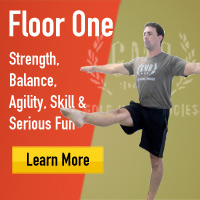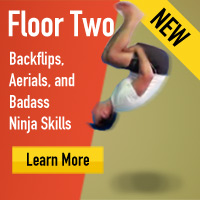Bigger. Faster. Stronger. Typical words used to describe most backyard athletic training motivations. But let’s talk about this. You often see people say “Train like an athlete!” What follows is normally wisdom to squat, bench press, and perhaps do some explosive work. But that isn’t training like an athlete. Now, I “get it.” I know “training [...]

Bigger. Faster. Stronger.
Typical words used to describe most backyard athletic training motivations.
But let’s talk about this.
You often see people say “Train like an athlete!” What follows is normally wisdom to squat, bench press, and perhaps do some explosive work. But that isn’t training like an athlete. Now, I “get it.” I know “training like an athlete” means getting away from two pound pink plastic coated dumbbells and treadmills.
When I think about the athletic archetype most people want, I think about NFL defensive backs, wide receivers, and running backs. Or any athlete that showcases a unique combination of looks and athletic ability, really. Adrian Wilson. Brian Dawkins. Andre Johnson. Vernon Davis. Jujimufu.
Squatting and benching alone won’t give you that combination. Doing some sprinting gets you “warmer,” but you still got a ways to go.
I’m from Pittsburgh. My Dad is a sports fanatic. (Bless him and his anxiety issues, as his passion for sports doesn’t do justice to his blood pressure.) So I grew up watching the Steelers, which gives me two athletic anecdotes.
First, I watch Polamalu fly around the field. (When he’s healthy, that is…) One of his hallmark plays: sacking Joe Flacco and forcing a fumble. That play is widely remembered by sports fans and commentators because it was an important turnover at an important time in the game. But to me the play is oh-so-much more. It’s a guy torpedoing his body into the air, colliding and latching onto an opponent, wrestling him to the ground, having the wits to barrel roll out of the tackle, entering full sprint after the barrel roll, and accelerating enough to throw two blocks before the play finishes.
Second, I watch film of former wide receiver, Lynn Swann. He’s considered one of the best of all time and is known for making incredible catches that involve immense body awareness and control.
Athleticism is more than sprinting, jumping, or Olympic lifting. It’s total body control in multi-directional, chaotic movement. Or what I like to call chaotic kinesthetic awareness: the ability to kinda where your body is in space even though things are happening so fast you can’t think. It’s “mastery” over your body. Dan John calls it “grace,” and I think that’s a perfect word for it.
Grace is easier to see in slow motion. Something as violent as throwing a javelin is graceful in slow motion. Tricking is similar. When you watch tricking in slow motion you see how the body works as a unit. How the head leads. How the shoulders and hips power. How the arms often operate in some kind of pattern with the legs. How the legs vibrate upon landings as harness and dissipate energy.
Gives me chills just thinking about it.
In nearly any feat of athleticism, the more coordinated you can connect yourself as one piece, the better. New tricksters are out of sync. Arms go at the wrong time. Legs push too early. Timing is just off. It’s usually too much of something and not enough of everything together. One piece dominates.
Back in my drawing days I remember being taught to look at my shading with squinted eyes to make sure it flowed smoothly from dark to light. To make sure one segment didn’t dominate the eye’s attention.
Good athletic ability is good shading. It’s smooth. It’s one piece. It’s graceful.
You can certainly describe Lynn Swann as graceful. That’s not surprising though; Swann took ballet. Ballet is all about making movement look effortless. Swann did just that.
Another example: Andreas Thorkildsen. Outside of Jujimufu, Andreas is my second man crush. Shouldn’t be much of a surprise for long time readers, as I’ve written about him before.
He’s one of the best javelin throwers around. His training, by traditional standards, is rather unconventional.
http://www.youtube.com/watch?v=2SURPu41Wao
Tumbling. Gymnastics. Ring work. Animal walks. A lot of stuff that—I think—most of us would overlook in favor of muscle building or strength work. But I guess the efficacy of that is rather stupid considering Andreas benches 400 pounds at 6’2” 200 pounds and a comfortably low body fat. Quite rare. His training certainly isn’t “limiting” much of anything.
I don’t think it’s a coincidence he actively works on his grace and total body coordination with gymnastics and tumbling exercises. And all he does is throw a pointed stick. Imagine the implications for a more chaotic sport.
This is why I’d be surprised if this kind of training didn’t become “normal” soon. When it does, remember: you heard it here first. Because I stole invented it.
The good news: you can up your grace game. Ultimate grace comes from practicing whatever it is you want to get good at and making it look effortless. Andreas can fling that pointed stick like a champ because he specializes in it. But that’s not to say his supplementary training doesn’t help.
In The Jackedthlete, I wrote about incorporating some of this coordination training into a normal routine, specifically combining it with the normal “get jacked” pump work. It’s a great combination that hits the aerobic system, works on graceful movement, and makes you look better naked.
Dare I ask if there’s anything more you could want training to do for you?
It’s sort of my go-to form of winter training. Being cooped up in the garage isn’t all that fun…unless you’re rolling around like a jackass. (Like me.) I’ve gotten a lot of e-mails about wanting to do sweet aerobic-acrobatic-athletic-aesthetic circuits. But there’s always an asterisk “I don’t know where to start! It’s easy for you with your young legs and tricking background.”
But that’s only partially true. As a recap, here’s a glimpse of a recent aerobic-acrobatic-aesthetic-athletic circuit (think I should just call them AAAA circuits from now on?):
- Macaco Bridging (well…attempting it anyway)
- Macaco Practice
- Ring Dips x 6
- Rolls, Rolls to Handstands
- Assorted Body Weight Junk
And for your own pleasure, I’ve created a spoof video from the past two training sessions of mine. Just to show you think kind of stuff isn’t always pretty. I’m far from perfect. The mess ups are real.
http://youtu.be/keSpOHW9s_c
The macaco is that bridge-backhandspring hybrid kinda thing. Want to know a secret about it?
I’m terrified of it. Flips never sat well with me. I have a decent vertical jump, which makes them rather easy for me. But my mind was never up to par with my physical capabilities. There’s always uneasiness. Not to mention I haven’t done any flips since breaking my foot in January 2011.
So how to do I go about chucking macacos then? How do I muster up the courage to roll end over end and literally crash on my garage floor?
The same way you can and should: you study, you learn, you ease into it.
I don’t make this stuff up. I don’t tell myself, “I’m going to do x, y, and z with zero practice and zero knowledge! Hope I survive lolz!” I learn from people more experienced than me. YouTube is a nice start. But the tutorials are often inconsistent because each move has a different demonstrator.
If you’re serious about things, I suggest Gold Medal Bodies and their floor programs. Gold Medal Bodies isn’t a stranger. They wrote one of the most read, shared, and useful posts here: Becoming a Handstand Beast. The stuff that’s inside their floor programs fits perfectly into AAAA circuits.
 Floor One is their first floor program and more suitable for beginners. It teaches you some balance maneuvers, basic tumbling exercises, and full body control. This resource is absolutely massive. There are three categories of movements inside: strength, balance, and coordination.
Floor One is their first floor program and more suitable for beginners. It teaches you some balance maneuvers, basic tumbling exercises, and full body control. This resource is absolutely massive. There are three categories of movements inside: strength, balance, and coordination.
Some of the things you’re looking at learning:
- Keeping your wits while jumping and spinning, and landing under control
- Handstands, cartwheels, roundoffs
- L-sit progressions
- Forward and backwards rolls
It’s a fully comprehensive resource.
 Floor Two just dropped, and is the follow up to Floor One. It’s more advanced. No doubt about it. It’s the flashier of the two and closer to my tricking “home.”
Floor Two just dropped, and is the follow up to Floor One. It’s more advanced. No doubt about it. It’s the flashier of the two and closer to my tricking “home.”
It squeezes the juice behind macacos, snakedowns, and other aerial tricks. Even stuff like floor circles. Tap into your inner breakdancer, yo.
If that isn’t enough, I got two more reasons to take a look at it:
- It’s on sale right now to celebrate its release
- You get my Tricking Primer guide for free when you buy
The primer is something Gold Medal Bodies asked me to contribute, and I’m all about spreading the name of tricking. So I went out in the freezing cold weather and shot tutorial videos for the basic tricks. I will never forgive Ryan for this, by the way. My fingers are still cold. There’s also write-ups for each basic trick in a coolio PDF.
Between Floor One and Floor Two, you’re looking at +89.6 athletic EXP. (Approximate value.) More than you can fathom, basically.
Now, here’s the deal: If you’re new you should go with Floor One. But Floor Two is one sale and you should snag that too because I know you’re going to get hooked on this stuff. There’s something much more addictive and stimulating about this kind of training. It challenges you in ways traditional barbell exercises can’t. And I know once you finish Floor One you’re going to want to jump into Floor Two. Trust me on that one.
I’m a huge fan of what GMB is doing from both an information and business conduct standpoint. They actually *gasp* encourage you to e-mail them. You won’t be disappointed with their product or lovely service. Their tutorials are comprehensive with safe progressions and ample preparation. And they even take into consideration options for those that are less comfortable with the skills.
So now is your chance to dive into this “stuff” you probably thought was never possible. With 2013 upon us, is there a better time? Is this the “new you”? And then when summer 2013 hits you can bask in your revitalized athletic fertility!
One last note here before I move on. I talk about program hoping a lot; how most people in this training world lose their focus, jump from program to program, and never make progress. This motivation to jump from one thing to another and learn new things is natural, but it kills sustained strength progress.
This “extra” training helps me avoid it because I’m always learning and trying new things, which keeps most of my barbell training in tact. It’s my channel against the mundane. And it’s a win win. I even get to explore and do things I never thought possible.
So what are you waiting for?
For a long of time, athletes let Olympic weightlifting invade their arena. If you were an athlete, you were expected to “borrow” some principles from weightlifting to better yourself and your skills. We’re entering a time when gymnastics, tumbling, and even dance are up for the same consideration.
So when you’re doing dive rolls to vertical jumps to 180 degree spins and sticking the landing, you can assure yourself that you’re “better off” than you were before. The key is to borrow just enough of these principles to be dangerous.
So I only recommend this “different” training — with the inclusion of Floor One and Floor Two — if you want to be awesome. If you want to have the same average program and do the the same average stuff then it’s just not for you.
Your call.
But it might be time to change your training — a move that might just change your life.
++++
photo credit: Tyson Cecka